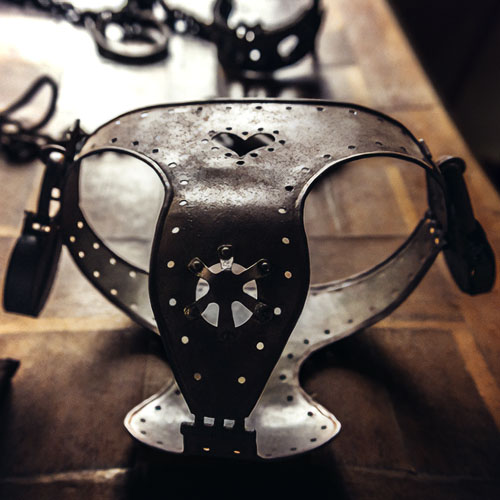Are races that include tire tunnels, greased monkey bars, and blood pits the future of fitness?
Hurts So Good — The Course of Obstacles
The water in the dumpster in front of you looks frigid — numbingly cold, even. You’re already shivering. You’re probably already wet. You’re definitely muddy. In spite of whatever training regimen you’ve diligently followed over the past few weeks and months, you still aren’t really ready for this obstacle. Or the next one, for that matter. Because in reality, it’s impossible to be fully prepared for an obstacle-course race like a Tough Mudder until you’ve actually finished one. And with names like that, you can’t exactly expect them to be easy.
They’ve been called the “safest most dangerous sport” in the world (Tough Guy), the “evolution of running” (Dirty Dash), and the “strongest race of all time” (Strong Man). But most obstacle events involve a certain amount of crawling, climbing, and swimming, along with the running. In truth, no matter how they’re described, these mental and physical challenges basically come down to two things: grime and punishment. You’ve got to be willing to get dirty. A high threshold for pain is also going to be an advantage. Over the past several years, however, in spite of their fearsome reputations, tens of thousands of people have entered and completed obstacle-course races. Relatively few have gone home with broken bones.
“It’s seriously going to physically hurt,” says Dan Yotive, an outdoor guide and former adventure-travel consultant who completed a Tough Mudder in New Jersey late last year.
“I was so cold, I was shivering uncontrollably — borderline hypothermic.”
Yet Yotive insists that he’s glad he tried a Tough Mudder, one of the most popular such events in the United States. “It was a fun time. I picked it because I wanted something where I could get my friends together and train together.”
And while 10 of his 12 friends dropped out before the day of the event, Yotive sounds happy to have stuck it out. “All the people there definitely added to the adrenaline rush.”
Since 2010, when Guy Livingstone and Will Dean launched their intimidatingly named enterprise, Tough Mudder has grown from three events (in California, New Jersey, and Pennsylvania) to 35, which will be held across the globe in 2012. The founders refer to their brainchild as “probably the toughest event on the planet,” a distinction earned in part by the stamina needed to cover as much as 12 miles over terrain made more challenging by the addition of tire tunnels and greased monkey bars. And while the organizers stress that every Mudder is about teamwork and camaraderie, competitiveness is certainly one attribute its participants share.
On the other hand, John Malfatto, race operations manager for the Dirty Dash, a regional mud-run obstacle-course series based out West, says, “We’d like to be the gateway drug to running and running events. This segment of the running market has blown up in the past three years.” He continues, “But we’re more medium-core. We want to be more inclusive. Just come out and be an idiot. I mean, we give prizes for dirtiest mustache.”
Malfatto has a compelling sales pitch. For the nonprofessional, pleasure can be a dependable source of motivation. Fortunately, pleasure and the urge to hurl yourself headfirst down the world’s longest mud slide go hand in hand at the Dirty Dash. But in case you’re still not satisfied (or filthy enough), the minds behind the madness are now working on a mud waterfall.
Other times, the fear of death can be an equally compelling motive, which is the idea behind Run for Your Lives — a 5K obstacle course populated by a zombie horde intent on catching each contestant. Runners are issued health points, represented by flags worn on a belt. Every health point you lose brings you closer to death. Setting out to capitalize on the craze surrounding The Walking Dead, a postapocalyptic television drama on AMC, cocreators Ryan Hogan and Derrick Smith initially planned to stage a single zombie race in 2011. As the day of the event drew near, however, they realized that they’d stumbled onto something much bigger. Roughly 10,000 people registered to participate in the first Run for Your Lives. This year they’ll host 11 events around the country. “We committed to a theme,” says Smith. “It’s fun, but it’s not a haunted house. The goal is — just for a split second — for people to feel like they’re in a zombie apocalypse.”
In other words, the exercise is a bonus. The volunteers who turn up early on race day to be transformed into shambling, brain-hungry undead add a level of difficulty to a race genre that usually depends on inanimate obstructions — but that doesn’t imply that any of the Run for Your Lives locations relies on mundane obstacles. Instead of mud, think blood — as in a blood pit. That and something called the “gut hanger,” which apparently involves a frightening amount of fake, albeit realistic, human entrails. How does anyone train for such obstacles? The event’s website helpfully offers seven words of advice: “Run. Watch zombie movies. Run some more.”
When it comes to true guts though, those who have unwavering confidence in their mental and physical fortitude can pit themselves against seriously daunting challenges — like Tough Guy in England, Vermont’s infamous Death Race, or the World’s Toughest Mudder, a more extreme version of the original contest. Tough Guy, located northwest of Birmingham on a large estate, subjects the willing — or foolhardy — to more than 100 “assaults” or obstacles: a 98-foot crawl under razor wire, a rope crossing two stories off the ground, a 30-foot-high climbing net, bogs and deep pools of liquid muck, claustrophobic tunnels, along with plenty of hill running. Death Race takes place in the woods of Vermont, and has lasted as long as 48 hours for some participants. In this race, which keeps its course map a secret, sheer hardship is the single obstruction — encountered again, and again, and again. Perhaps more than anything else, these challenges are designed to test the body and break the spirit. Death Race organizers, for example, boast about a 15 percent completion rate for would-be endurance athletes. In 2011, that meant 35 people. Tough Guy, on the other hand, advertises with a rhetorical question: “Where in this wide wonderful world can you find such grace laced with fear, panic, and claustrophobia?”
When viewed alongside friendlier 5K obstacle courses like the Dirty Dash, Rugged Maniac, and Warrior Dash, these grueling events appear to belong in a completely different league. Anything that involves chopping wood for two hours straight (like the Death Race does) is not for the occasional gym-goer. Nor is a course that promises thickets of stinging nettles and murky ponds teeming with leeches. It’s one thing to earn a cold beer, a cheesy medal, and a new T-shirt after working every muscle in your body in one of the traditional 5K races. It’s another thing altogether to spend $900 on a day that guarantees severe discomfort and the sacrifice of a certain amount of your own blood. Even so, demand for obstacle-course races seems only to grow.
“We’re basing our success on a culture that may be getting bored with endurance-running events,” says Alex Patterson, Tough Mudder’s chief marketing officer. “People are soft,” he continues matter-of-factly. “And everything out there makes life easier. We want you to know the visceral satisfaction of climbing over a ten-foot wall.”
Ignoring the wide range of hardship involved, the main thing most obstacle races have in common is a commitment to devote a percentage of their proceeds to charities, often ones that benefit needy children or military veterans. Rugged Maniac encourages runners to donate to the Fisher House Foundation, a program that provides lodging to military families who can’t afford to visit relatives in recovery. Spartan Race, which stages four classes of obstacle events including the Death Race, raises money for Homes for Our Troops, a charity that builds houses for severely injured veterans. Warrior Dash entrants have the option to fundraise for St. Jude Children’s Research Hospital, an institution that is working to combat pediatric cancer. Tough Mudder participants, meanwhile, have collected close to $3 million for the Wounded Warrior Project, an apolitical organization that seeks to honor and empower injured service members.
“No matter how they’re described — blood pit, gut hanger, mud run — these mental and physical challenges all basically come down to two things: grime and punishment.”
So, once you’ve determined your pain tolerance and the charitable institution you’d like to support, how does a guy who finds most of his stimulation in the bedroom go about training for an intense obstacle-course experience?
“A lot of people do things like CrossFit,” claims Tough Mudder veteran Yotive, referring to the branded fitness program that favors a broad regimen of workouts over specialization. “I just ran a bunch of times. And I did reps of push-ups, squats, box jumps, and sit-ups as long as I could. Then I stepped it up until I could do two hours without really stopping.” He paused, as if to reconsider the amount of preparation truly necessary for a Tough Mudder.
“But my friend Alex made it, and he’s a big smoker and drinker.”
In some cases, willpower can make up for a certain lack of physical ability. When speaking about the event he helped turn into a phenomenon, Patterson prefers to describe Tough Mudder in terms of a new type of fitness goal. “We wanted to marry endurance with military-style obstacles,” he says. “A lot of people want a taste of military training, but not everyone wants to join the Marines.”
It’s worth noting that in order to begin training with the Marines, male recruits must do two pull-ups, 35 crunches in two minutes, and run one and a half miles in 13:30. Lifting 10 to 30 pounds of rocks for up to five hours, as past Death Race participants have done, raises the bar even higher than the Combat Fitness Test, a requirement all Marines must pass annually. This performance assessment involves an 880-yard sprint, a timed 30-pound ammunition lift, and a combat-related event called Maneuver Under Fire. In practice, a serviceman on a tour of duty may face tougher challenges. For Marines on base, however, their entire test will be over in 11 minutes or less. Death Racers, on the other hand, can be on the course for as long as 48 hours. And those Tough Guys in the United Kingdom? Well, let’s just say that they affectionately refer to some of the tougher sections of their course as the Killing Fields, two laps around nongenetically modified stinging nettles; the Torture Chamber, a gauntlet of slippery tires; and the Battle of the Somme, a run through fire pits.
“We’re not Tough Mudder,” admits Smith as he provides more details about Run for Your Lives. “You have the option to skip obstacles. We make the course challenging, not impossible.”
Similarly, Malfatto and his Dirty Dash business partners don’t see themselves in competition with the more extreme obstacle-course events. “We’re more about having a good time,” he says. “Anyone can do it. In Billings [Montana], people were drinking beer at the starting line.”
Beer on race day? Now that doesn’t sound too hard.
All in all, it sounds pretty dirty — and not in the same way that we usually get accused around here, oddly enough. Being us, of course, out here in the land “No Naked People” for the company, we wondered about the science of mud. Full disclosure, that was about as dull as we feared, so we quickly rotated to the Mud Pie Drink. That sounded more fun, but you can browse as the mood (or mud) suits you.

























